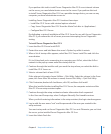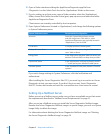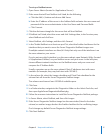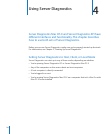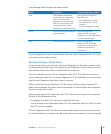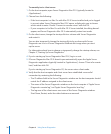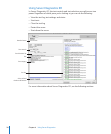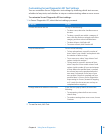
To temporarily change the startup disk at startup:
1 Restart the server.
2 While the server is restarting, hold down the Option key until a list of volumes appears.
If you’re asked to authenticate, enter the rmware password and click the Continue
(right-arrow) button.
If you haven’t erased the preinstalled Mac OS X Server volume with Server Diagnostics
EFI, you can start up Server Diagnostics EFI by holding down the D key instead of the
Option key.
To start up Server Diagnostics EFI from a NetBoot image hosted on a NetBoot server,
hold down the F1 key instead of the Option key.
Each alternative starts up Server Diagnostics EFI and bypasses the list of volumes
described in the next step.
3 If you displayed the list of volumes instead of immediately starting up Server
Diagnostics, select the volume with Server Diagnostics, and then click the arrow
button to start up.
The Server Diagnostics EFI volume is listed as EFI Boot. If you’ve inserted the Admin
Tools disc in another computer with Mac OS X or Mac OS X Server v10.6 or later
installed and you run Remote Install Mac OS X, the Server Diagnostics EFI volume is
listed as Administration Tools.
After you nish using Server Diagnostics EFI and restart the server, it starts up from the
default startup volume.
Disabling the Firmware Password
If a rmware password is enabled, you can’t temporarily change the startup volume by
pressing and holding F1 or D at startup.
If a rmware password is enabled and you try to temporarily change the startup
volume by holding down the Option key at startup, you must authenticate.
To disable the rmware password:
1 Insert the Mac OS X Server Install DVD.
2 Restart the server and hold down the server’s Option key while it restarts.
3 When a list of startup disks appears, select Mac OS X Server Install Disc and click the
arrow button.
If the disk isn’t listed and you’re connecting to a computer over AirPort, select the
AirPort network in the pop-up menu under the startup disk list.
22 Chapter 3 Starting Up Server Diagnostics




